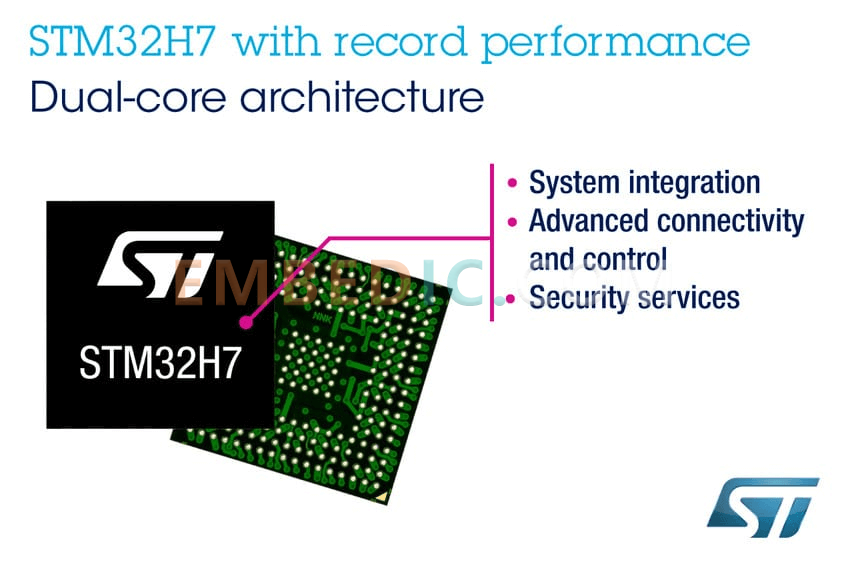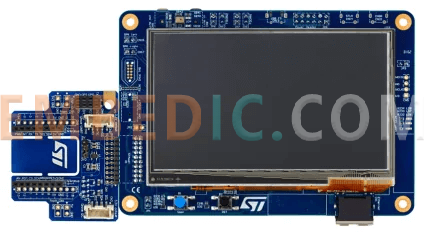ST's STM32H7 microcontrollers make this family of MCUs more powerful, flexible and easy to use. STM32H745 / STM32H755 and STM32H747/STM32H757 are ST's first dual-core models, with Cortex-M7 running at 480 MHz and Cortex-M4 running at 240 MHz, resulting in a CoreMark score of 3220.

On the other hand, we also officially released the STM32H742 and STM32H750, both getting the same Cortex-M7 at 480 MHz, but offering a cost-effective architecture that makes the H7 series more affordable. As such, this is a highly symbolic announcement as it extends this family of MCUs to make them relevant to a wider range of designs and ensures that more customers find the performance, features and price points relevant to their applications.
The STM32H7 has became the most powerful Cortex-M7 on the market. For example, the new STM32H742 removes the TFT LCD controller and JPEG codec unit, while also reducing RAM to 692 kB to ensure that systems that do not require a display find a better value proposition in it.
Similarly, we announced last year the creation of the STM32H7 Value Line thanks to much less flash memory, so designers who need an external QuadSPI for graphics-intensive applications don't have to pay for embedded storage they will never use.
The most obvious performance boost comes from the addition of the Cortex-M4 core, which raises the CoreMark score by 800 points. However, it is easy to overlook the fact that, beyond simply adding a processing unit, it is its implementation in the chip that makes the STM32H745/STM32H755 and STM32H747/STM32H757 truly unique. Thanks to the superb design, this dual-core architecture is very flexible.
For example, the system can be booted on either core, and their respective presence in separate power domains significantly optimizes energy consumption. For example, when an application does not need the Cortex-M7, developers can turn off its power domain without any impact on the other cores. As a result, the dynamic power consumption of the new dual-core model is far superior to that of the STM32F7.
Utilizing multiple cores may seem daunting, but companies that have already written applications for our Cortex-M7 or Cortex-M4 STM32 can reuse some of their code and build on top of it.
For example, a company using an STM32 Cortex-M4 to control an industrial pump could take their existing application and then run the new display and GUI on the Cortex-M7 to add new functionality to their product without rewriting everything. Very simply, engineers can benefit from having two MCUs without the complexity and design challenges of having two different components on the PCB.
Improvements to the lithography operation also allow us to introduce the MIPI Display Serial Interface (MIPI-DSI) for the first time in the STM32H7. This feature in the STM23H7x7 allows the use of higher resolution displays and provides low EMI while consuming low power, making it ideal for portable video game consoles or appliances, for example.
Likewise, the new STM32H7x5 and STM32Hx7 allow more flexible use of the three 16-bit analog-to-digital converters on the chip (up to 3.6 megasamples per second). Its two FD-CAN interfaces and its Ethernet controller also offer excellent advantages for industrial applications.
You may like: First HD screen with STM32H7 to Provide Beautiful GUI Graphical Display for Different Screen Sizes
Optimization of our process has also resulted in new features available on all new STM32H7 and existing STM32H7x3, which have been available since April using different revisions. Our datasheet refers to this as "Rev V", and its Finish Good number ends with a "7" (i.e. 32H743IIT6$Y7). Among other things, the new version brings Dual Bank Flash, except for the STM32H750, which relies on 128 kB of embedded Flash and external Flash.
Dual Bank Flash divides the storage capacity into two parts, the first for applications, but allows loading new firmware in the second part and then performing a hot swap to run the system on the latter without interruption, enabling major updates without downtime.
Another feature is the Root Security Service (RSS), present on STM32H7 with encrypted cores (i.e. STM32H75x), including STM32H753 Rev V. In the form of a bootloader, engineers can use it to securely install firmware. Since the MCU stores the encryption key, the company can ship the encrypted firmware to the assembly line responsible for installing it, and the decryption operation is performed only within the MCU to protect the IP and prevent hacking.
In addition, we offer "anti-protection", which means that developers can define the number of MCUs that will receive the firmware, and if the system reaches the upper limit, the component will stop its installation operation. It allows engineers to know if someone has installed their firmware on a component that is not part of their inventory, thus preventing leakage to the gray market.
Improving foundry operations also allows us to make the necessary optimizations for the current STM32H7 architecture, such as the ambient temperature at maximum power consumption (T Jmax 125 ºC). If the previous model had an upper threshold of 85 ºC, the new STM32H7 can now safely reach 105 ºC.
In addition, to ensure that all variants of the STM32H7 benefit from this release, the STM32H7x3 Rev V MCU will also be able to operate at this new ambient temperature. From 85 ºC to 105 ºC means the ability to run specific applications without active heat dissipation, thus benefiting from the silence of the heat sink.
It also opens the product to a broader range of environments. In addition, the dual-core version of the STM32H7 includes a switched-mode power supply (SMPS), which significantly improves the power efficiency of the MCU compared to microcontrollers using more traditional LDOs.
The gain is so great that if engineers use the SMPS, they can increase the maximum junction temperature to 140 ºC while limiting the frequency limit to 300 MHz, which is much lower than the higher temperatures sometimes advertised but required. It also proves that unlike traditional designs that struggle to improve efficacy when more processing cores are added, our new architecture bucks the trend and delivers better power consumption, even after adding entirely new cores.
Grab a board and get started!
The best way to start experimenting with our STM32H7x7 dual-core MCU is to get the STM32H747I-EVAL or STM32H747I-DISCO board. The latter integrates a 4-inch MIPI-DSI touchscreen to facilitate GUI development, and in a few months, both boards will have an alternative version carrying the encryption core (i.e. STM32H757I-EVAL and STM32H757I-DISCO).
Likewise, engineers interested in the STM32H750 Value Line can purchase the STM32H750B-DK Discovery board, which will feature a 4.3-inch TFT display and come with a TouchGFX demo. They may also get one of the many Nucleo boards that will feature one of these new components.
 (STM32H750B-DK)
(STM32H750B-DK)
Manufacturer: Analog Devices
IC DSP 12BIT 400MHZ 120LQFP
Product Categories: DSP
Lifecycle:
RoHS:
Manufacturer: Microchip
IC MCU 32BIT 32KB FLASH 28QFN
Product Categories: 32bit MCU
Lifecycle:
RoHS:
Manufacturer: Microchip
IC MCU 8BIT 14KB FLASH 44QFN
Product Categories: 8bit MCU
Lifecycle:
RoHS:
Manufacturer: Texas Instruments
IC DSP 181CPGA
Product Categories: DSP
Lifecycle:
RoHS:
Looking forward to your comment
Comment